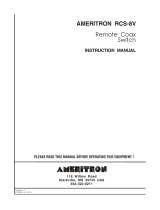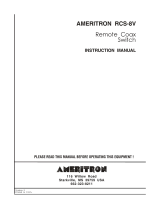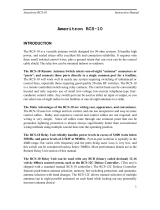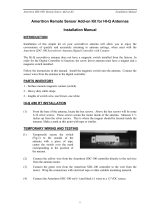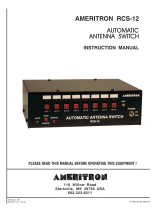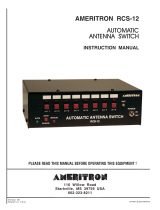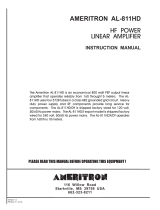
1
INSTALLATION
The relay box may be mounted on a tower leg, mast or
building wall. The mounting hardware furnished will accept a
tubular mast up to 1 ½” diameter.
If the box is mounted on a building wall discard the “U” bolt
assembly and use two ½” screws to attach the bracket to the
wall.
The relay box must be mounted with the connectors down.
Do not attempt to air seal the relay box. Install drip loops
below the box if the feedlines are brought in from a higher
location. Lightning retarding loops area recommended
precaution on all cables (see illustration).
Relay Box Cable Connections
Connect your antennas to coax connectors numbered 1-4 and
note which antenna is connected to each socket.
Connect a coax lead to the connector marked “CONTROL
CONSOLE.” This lead should be long enough to attach to the
control console.
If control power fails, the relay box selects antenna “4”. It
would thus be wise to put the most frequently used antenna in
position 4.
Control Console Connections
Locate the RCS-4 control console at a convenient location on
the station operating desk.
The control console supplies 12V AC and DC control
voltages. It has an internal 1A fuse in the transformer
secondary circuit that protects the power supply if a short
circuit occurs in the feedline. Caution must be exercised
when connecting the RCS-4 to prevent damage to station
equipment.
Use coax to connect the “STATION” SO-239 connector to
the output connector of your transceiver, amplifier or tuner.
Connect the coaxial line from the relay box to the “RELAY
BOX” SO-239 connector.
DO NOT CONNECT THE “RELAY BOX” CONNECTOR
TO THE STATION. CONNECT IT TO THE RELAY BOX
FEEDLINE ONLY. DO NOT “HOT SWITCH” THE
RELAY BOX WITH POWER LEVELS OVER 100 WATTS.
THERE SHOULD BE NO PIECE OF EQUIPMENT
BETWEEN THE INDOOR AND OUTDOOR BOX.
OPERATION
1. Plug the line cord into a 117 VAC outlet.
2. Place the PWR switch in the “ON” position.
3. Rotate the SELECT control and observe the lights
one through four.
The switch positions are numbered on the front of the control
box and a space is provided above each position so you can
pencil in its designation for each antenna.
GROUNDING
The RCS-4 has small air gaps near each antenna connector on
the printed circuit board to protect against lightning damage.
We strongly recommend the use of lightning retarding loops
in the coaxial cables near the relay box (see illustration).
Remember that lightning travels through the path of least
resistance. Station ground leads should be solid, large surface
area conductors. Do not use braided or stranded wire for the
ground leads. Avoid sharp bends in the ground leads. Use
multiple ground rods and/or radials to provide the earth
termination.
THIS LENGTH MAY VARY UP TO
3 FT. IT MUST NOT CONTACT
THE MAST OR TOWER
TAPE TO THE MAST OR TOWER FOR
SUPPORT NEAR THE RELAY BOX
MOUNTING LOCATION
2 TURNS 6” DIA. ON ALL CABLES
LEAVING AND ENTERING THE
RELAY BOX. KEEP COILS SPACED
FROM EACH OTHER BY VERTICAL
OR HORIZONTAL SEPARATION OF
2” MINIMUM
TO ANTENNA
LIGHTNING RETARDING LOOPS
IMPORTANT
There should be no piece
of equipment between the
indoor and outdoor box.
Only a piece of coax should
be used.
IMPORTANT
NEVER switch antennas with more than 100 watts
RF power applied to the feedline. Damage to the
switching contacts may result from “hot switching.”




